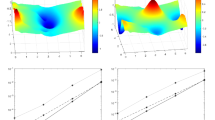Abstract
We propose an algorithm to sample and mesh a k-submanifold \({\mathcal{M}}\) of positive reach embedded in \({\mathbb{R}^{d}}\) . The algorithm first constructs a crude sample of \({\mathcal{M}}\) . It then refines the sample according to a prescribed parameter \({\varepsilon}\) , and builds a mesh that approximates \({\mathcal{M}}\) . Differently from most algorithms that have been developed for meshing surfaces of \({\mathbb{R} ^3}\) , the refinement phase does not rely on a subdivision of \({\mathbb{R} ^d}\) (such as a grid or a triangulation of the sample points) since the size of such scaffoldings depends exponentially on the ambient dimension d. Instead, we only compute local stars consisting of k-dimensional simplices around each sample point. By refining the sample, we can ensure that all stars become coherent leading to a k-dimensional triangulated manifold \({\hat{\mathcal{M}}}\) . The algorithm uses only simple numerical operations. We show that the size of the sample is \({O(\varepsilon ^{-k})}\) and that \({\hat{\mathcal{M}}}\) is a good triangulation of \({\mathcal{M}}\) . More specifically, we show that \({\mathcal{M}}\) and \({\hat{\mathcal{M}}}\) are isotopic, that their Hausdorff distance is \({O(\varepsilon ^{2})}\) and that the maximum angle between their tangent bundles is \({O(\varepsilon )}\) . The asymptotic complexity of the algorithm is \({T(\varepsilon) = O(\varepsilon ^{-k^2-k})}\) (for fixed \({\mathcal{M}, d}\) and k).
Similar content being viewed by others
References
Abresch U., Meyer W.T.: Injectivity radius estimates and sphere theorems. In: Grove, K., Petersen, P. (eds) Comparison Geometry., Mathematical Sciences Research Institute (MSRI) Publications, Berkeley (1997)
Amenta N., Choi S., Dey T.K., Leekha N.: A simple algorithm for homeomorphic surface reconstruction. Int. J. Comput. Geom. Appl. 12(1–2), 125–141 (2002)
Berger M.: Geometry 2. Universitext, Springer, Berlin (1990)
Bhaniramka P., Wenger R., Crawfis R.: Isosurface construction in any dimension using convex hulls. IEEE Trans. Vis. Comput. Graph 10(2), 130–141 (2004)
Boissonnat J.-D., Flototto J.: A coordinate system associated with points scattered on a surface. Comput.-Aided Des. 36, 161–174 (2004)
Boissonnat, J.-D., Ghosh, A.: Manifold reconstruction using tangential Delaunay complexes. In: Proceedings of 26th Annual Symposium on Computational Geometry (2010, in preparation)
Boissonnat J.-D., Oudot S.Y.: Provably good sampling and meshing of surfaces. Graph. Models 67, 405–451 (2005)
Boissonnat, J.-D., Oudot, S.Y.: Provably good sampling and meshing of Lipschitz surfaces. In: Proceedings of ACM Symposium on Computational Geometry, pp. 337–346 (2006)
Boissonnat, J.-D., Wormser, C., Yvinec M.: Locally uniform anisotropic meshing. In: Proceedings of ACM Symposium on Computational Geometry, pp. 270–277 (2008)
Cairns S.S.: A simple triangulation method for smooth manifolds. Bull. Am. Math. Soc. 67(4), 389–390 (1961)
Cazals F., Giesen J.: Delaunay triangulation based surface reconstruction. In: Boissonnat, J.-D., Teillaud, M. (eds) Effective Computational Geometry for Curve and Surfaces, Springer, Berlin (2006)
Cheeger J., Gromov M., Taylor M.: Finite propagation speed, kernel estimates for functions of the Laplace operator, and the geometry of complete Riemannian manifolds. J. Differ. Geom. 17, 15–53 (1982)
Cheng, S.-W., Dey, T.K., Ramos, E.A.: Manifold reconstruction from point samples. In: Proceedings of ACM-SIAM Symposium Discrete Algorithms, pp. 1018–1027 (2005)
Chew, L.P.: Guaranteed-quality Delaunay meshing in 3D. In: Proceedings of ACM Symposium on Computational Geometry, pp. 391–393 (2006)
Clarkson, K.: Building triangulations using \({\varepsilon}\) -nets. In: Proceedings of ACM Symposium on Theory of Computing, pp. 326–335 (2006)
Dey, T.K., Li, K.: Topology from data via geodesic complexes. Tech Report OSU-CISRC-3/09-TR05 (2009)
Dudley R.M.: Metric entropy of some classes of sets with differentiable boundaries. J. Approx. Theory 10, 227–236 (1974)
Edelsbrunner H.: Geometry and Topology for Mesh Generation. Cambridge University Press, Cambridge (2001)
Federer H.: Curvature measures. Trans. Am. Math. Soc. 93(3), 418–491 (1959)
Federer H.: Geometric Measure Theory. Springer, New York (1969)
Fu J.H.G.: Convergence of curvatures in secant approximations. J. Differ. Geom. 37, 177–190 (1993)
Giesen, J., Wagner, U.: Shape dimension and intrinsic metric from samples of manifolds. In: Proceedings of ACM Symposium on Computational Geometry, pp. 329–337 (2003)
Gray A.: Tubes. Addison-Wesley, Reading (1990)
Gruber P.M.: Asymptotic estimates for best and stepwise approximation of convex bodies I. Forum Math. 5, 281–297 (1993)
Gruber P.M.: Optimum quantization and its applications. Adv. Math. 186, 456–497 (2004)
Henderson M.E.: Multiple parameter continuation: computing implicitly defined k-manifolds. Int. J. Bifurc. Chaos 12(3), 451–476 (2002)
Kamenev G.K.: The initial convergence rate of adaptive methods for polyhedral approximation of convex bodies. Comput. Math. Math. Phys. 48(5), 724–738 (2008)
Li X.-Y.: Generating well-shaped d-dimensional Delaunay meshes. Theor. Comput. Sci. 296(1), 145–165 (2003)
Min C.: Simplicial isosurfacing in arbitrary dimension and codimension. J. Comput. Phys. 190, 295–310 (2003)
Munkres, J.R.: Elementary differential topology. Annals of Mathematics Studies. Princeton University Press (1966)
Niyogi P., Smale S., Weinberger S.: Finding the homology of submanifolds with high confidence from random samples. Discrete Comput. Geom. 39(1), 419–441 (2008)
Peyré G., Cohen L.: Geodesic computations for fast and accurate surface remeshing and parameterization. Prog. Nonlinear Differ. Equ. Appl. 63, 157–171 (2005)
Ruppert J.: A Delaunay refinement algorithm for quality 2-dimensional mesh generation. J. Algorithms 18(3), 548–585 (1995)
Whitehead J.H.C.: On C 1-complexes. Ann. Math. 41, 809–824 (1940)
Whitney H.: Geometric Integration Theory. Princeton University Press, Princeton (1957)
Author information
Authors and Affiliations
Corresponding author
Additional information
This research has been partially supported by the Agence Nationale de la Recherche (project GAIA 07-BLAN-0328-04).
Rights and permissions
About this article
Cite this article
Boissonnat, JD., Ghosh, A. Triangulating Smooth Submanifolds with Light Scaffolding. Math.Comput.Sci. 4, 431 (2010). https://doi.org/10.1007/s11786-011-0066-5
Received:
Revised:
Accepted:
Published:
DOI: https://doi.org/10.1007/s11786-011-0066-5
Keywords
- Manifold triangulation
- Meshing
- Manifold learning
- Manifold sampling
- Computational geometry
- Computational topology




